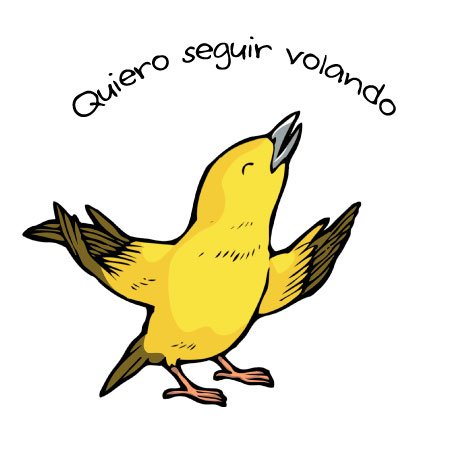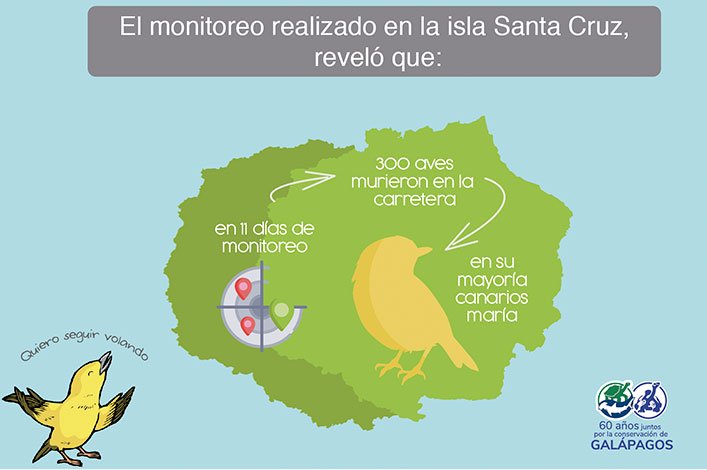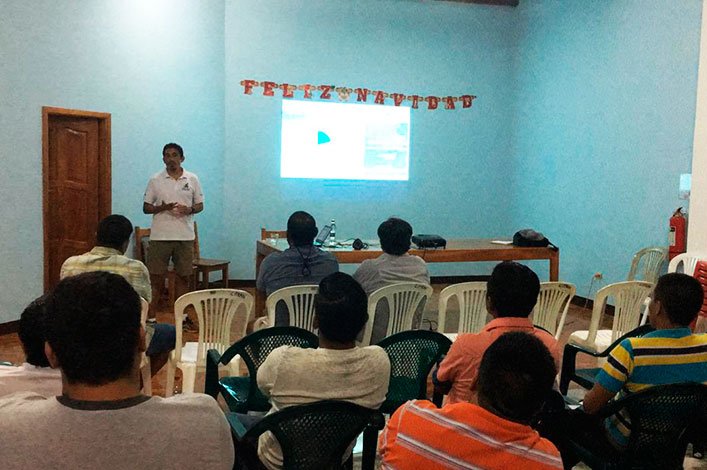"I want to keep flying" (Quiero seguir volando in Spanish) is the campaign being carried out in the Galapagos Islands to reduce the number of birds that die on the road due to vehicle impacts. The campaign was launched in Puerto Ayora, Santa Cruz, in April 2019 by the Charles Darwin Research Station together with the Directorate of the Galapagos National Park.
Every day the resident birds of Galapagos face the threat of being run over on the roads of the islands. Due to several factors such as speeding of more than 90km/h, the increasing number of vehicles and vegetation on the roadway, and the lack of road signs, etc.
Among the most affected birds we have endemic species (that is, those that cannot be found anywhere else in the world), such as the yellow warblers (canario María), Darwin finches, owls, among others; although native, migrant and introduced species are also run over.

"I want to keep flying" was a slogan developed by Luis Moreno with the support of the Galapagos National Park Directorate, as a local community initiative that aims to raise awareness among drivers and the community, thus reducing the death of birds on Galapagos expressways due to vehicle impacts.
In addition, there are other NGO´s and public institutions that have been involved in this issue along with the Charles Darwin Foundation for more than 20 years.
Increased mobility through vehicles
In the 1980s there were fewer than 30 vehicles registered in Galapagos, while in 2016 there were more than 1200 vehicles. The violation of traffic laws by speeding created a new problem: the mortality of birds on the roads. In addition, today there is a different use of roads because there is supply needs from Puerto Ayora to the Itabaca Canal, for tourism boats, and supply of goods coming from the mainland to the island community from the airport.
294 fatal collisions in 11 monitoring days
In 2018, during a monitoring period of 11 days distributed throughout the year on Santa Cruz Island, 294 fatalities of birds were recorded, all birds hit by cars. The extrapolation is of more than 9000 birds a year!

Drivers travel the Galapagos landscape at speeds greater than those permitted instead of 50km/h at 70 km/h, and endanger mainly male and adult birds.
Roads attract birds because they are a source of resources, where they can find food (seeds, insects, gravel), water, rest and to cross from one area to another.
Among the main recommendations to avoid collisions is to maintain the maximum permitted speed and honk if a bird is seen. Especially in the mating season, from January to July, when birds are most active on the road.
As part of the "I want to keep flying" campaign, presentations are being rolled out to the drivers of the service companies', and in the coming months to the drivers and the community in general, where environmental issues are discussed. The talks are given by the Galapagos National Park Directorate (GNPD) and Charles Darwin Foundation (CDF) staff, and have been well received by the drivers and the community.

During the talks, scientist Gustavo Jiménez (CDF), project leader, and Galo Quezada from GNPD, talk about the mortality of birds by automobiles and provide information on the necessary recommendations to diminish the impact.
"We have had a great reception during the trainings, the drivers show real interest in this very important topic", says Jiménez.
The next cycle of presentations talks is planned for the end of May and start of June.
Presentations for the community will take place in July, during the Science Symposium of the Galapagos National Park Directorate and the Charles Darwin Foundation. In addition, talks have been planned for local institutions such as the Galapagos Government Council, Santa Cruz Municipal Government, Galapagos Biosecurity Agency, other government institutions, the Ecuadorean Navy, NGOs, among others.






